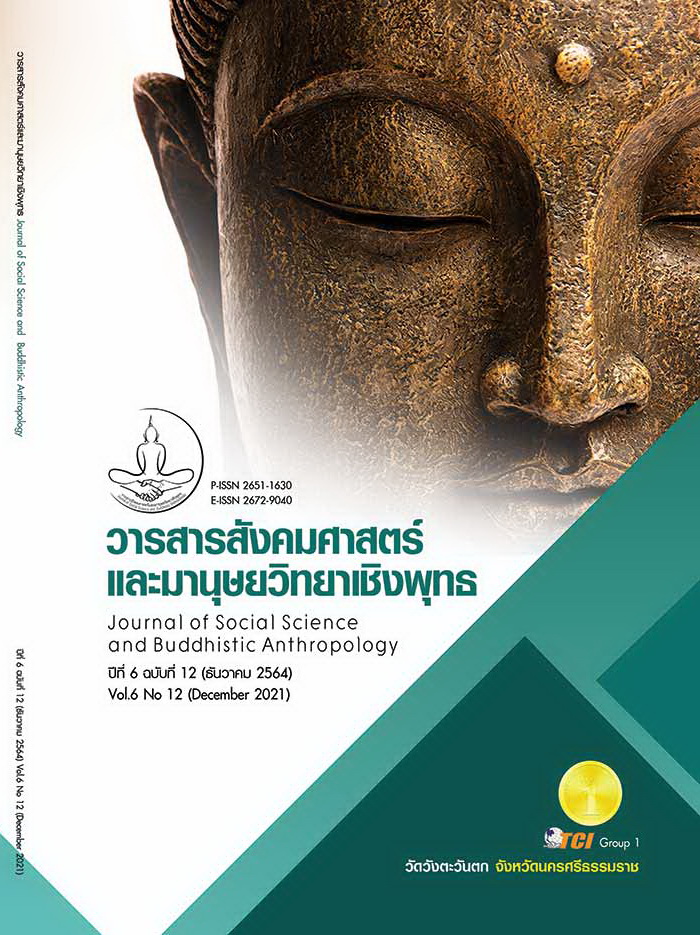FASHION LIFESTYLE PRODUCTS FROM DEVELOPING ETLINGERA ELATIOR FIBER
Keywords:
Product Development, Fashion Lifestyle, Textile Innovation, Etlingera Elatior FiberAbstract
The objective of this research article was to determine the guidelines for creating textile innovation from the surplus Etlingera elatior to use in the design and processing process together with the waste material in Songkhla Province in the form of fashion lifestyle products to increase the value of Etlingera elatior, which is the agricultural waste, and create the value to the material in community, by conducting qualitative research By creating research tools using questionnaires and interviews with experts. Stakeholders A group of textile entrepreneurs and designers. Research results indicated that Etlingera elatior fiber obtained from the stem was tough and long. The fiber is hit, it will be hard and easily broken. For this reason, the Etlingera elatior fiber was twisted with cotton at a ratio of 15 : 85. Cotton helped to soften the touch and maximize flexibility. For color extraction from the Etlingera elatior flower’s petals, blended the petals with water at the ratio of 1 : 1 and boiled one liter of water with 200 g. of salt. Before dyeing, soak the fiber in the mordant for 15 minutes. Soaked the cotton in the guava leaf water and silk in tamarind paste before boiling them with the extracted color water for one hour. Soaked them in the mordant again before washing with water and let it dry. As a result, the Etlingera elatior fiber was thick and suitable for making the house decoration products or furniture. In which the researcher has created textiles with waste materials, namely palm and rubber waste. In the form of fashion lifestyle products, consisting of chairs, lamps made of Etlingera elatior fabric and palm wood, cushions made from rubber scraps mixed with dried Etlingera elatior fiber, clothes, bags, and shoes.
References
กรมพัฒนาธุรกิจการค้า กระทรวงพาณิชย์. (2563). ความรู้เรื่องเนื้อผ้าและเส้นใย. เรียกใช้เมื่อ 30 สิงหาคม 2564 จาก https://www.Ruedee.com/th/fabric/
กัญจิรา ส่งไพศาล. (2563). เส้นใยกัญชง แบรนด์ทักทาย. เรียกใช้เมื่อ 30 สิงหาคม 2564 จาก https://www.taktaibrand.com/about-taktai/
คำนาย อภิปรัชญาสกุล. (2557). สินค้าและบรรจุภัณฑ์. (พิมพ์ครั้งที่ 1). กรุงเทพมหานคร: โฟกัสมีเดียแอนด์ พับลิชชิ่ง.
ชุลีกร เทพบุรี และคณะ. (2562). ปัจจัยที่ส่งผลต่อการตัดสินใจเลือกใช้บรรจุภัณฑ์เพื่อสิ่งแวดล้อมของผู้ประกอบการรายย่อย. วารสารมนุษยศาสตร์และสังคมศาสตร์, 3(1), 50-58.
ดรุณี แวเด็ง. (11 พฤษภาคม 2561 ). ผู้ประกอบการด้านสิ่งทอในจังหวัดสงขลา. (นภท์ชนก ขวัญสง่า, ผู้สัมภาษณ์)
ดาริกา ดาวจันอัด และคณะ. (2558). การสร้างมูลค่าเพิ่มให้กับดาหลาเชิงพาณิชย์ ด้วยการสกัดเส้นใยจากลำต้นดาหลาเพื่อใช้ในอุตสาหกรรมการทอผ้าในจังหวัดนราธิวาส. ใน รายงานการวิจัย. กรมวิชาการเกษตร กระทรวงเกษตรและสหกรณ์.
ปิยาภรณ์ ประทุมมา และคณะ. (2559). สีธรรมชาติ กระบวนการและมาตรฐานการย้อม. (พิมพ์ครั้งที่ 1). กรุงเทพมหานคร: กรมหม่อนไหม กระทรวงเกษตรและสหกรณ์.
ผู้จัดการออนไลน์. (2563). ขยะ+ไอเดีย=Upcycling. เรียกใช้เมื่อ 30 สิงหาคม 2564 จาก https://mgronline.com/mutualfund/detail/9630000080801
พิทักษ์ อุปัญญ์ และคณะ. (2563). การพัฒนาผลิตภัณฑ์เส้นใยลูกตาลในเชิงอุตสาหกรรมสิ่งทอ. เรียกใช้เมื่อ 12 สิงหาคม 2564 จาก https://www.gotoknow.org/posts/408458
ไพโรจน์ บุตรชีวัน. (2559). การศึกษาความสัมพันธ์เชิงสาเหตุของปัจจัยที่มีผลต่อการเป็นองค์กรแห่งนวัตกรรมของผู้ประกอบการวิสาหกิจขนาดกลางและขนาดย่อมเพื่อสร้างความได้เปรียบในการแข่งขันอย่างยั่งยืน. วารสารเทคโนโลยีภาคใต้, 9(2), 85-97.
มติชนบทเทคโนโลยีชาวบ้าน. (2563). คิดเป็นเทคโน. เรียกใช้เมื่อ 30 สิงหาคม 2564 จาก http://info.matichon.co.th/techno/techno.php?srctag=05089010158&srcday=&search=no
รัฐนันท์ พงศ์วิริทธิ์ธร และกัญญากาญจน์ ไซเออร์ส. (2559). แนวทางการพัฒนาการท่องเที่ยวจังหวัดเชียงใหม่ตามทัศนะของนักท่องเที่ยวเพื่อความยั่งยืน. วารสารวิชาการมหาวิทยาลัยธนบุรี, 10(22), 60-66.
สถาบันพัฒนาอุตสาหกรรมสิ่งทอ. (2561). แนวทางการออกแบบและพัฒนาผลิตภัณฑ์สิ่งทอ. เรียกใช้เมื่อ 30 สิงหาคม 2564 จาก https://www.thaitextile.org/th/insign /downloadsrc.preview.35.html.
สถาบันพัฒนาอุตสาหกรรมสิ่งทอ. (2564). สถาบันพัฒนาอุตสาหกรรมสิ่งทอกับ BCG ECONOMY. ใน รายงานโครงการศูนย์สารสนเทศอัจฉริยะอุตสาหกรรมแฟชั่นปี 2564. สถาบันพัฒนาอุตสาหกรรมสิ่งทอ.
สุรวิช วรรณไกรโรจน์. (2563). การปลูกดาหลา. เรียกใช้เมื่อ 12 สิงหาคม 2564 จาก http://alangcity.blogspot.com/2014/01/blog-post_25.html
สุวิทย์ วงศ์รุจิราวาณิชย์. (2554). Sustainable Design ดีไซน์...เปลี่ยนโลก. กรุงเทพมหานคร: กรุงเทพธุรกิจ.
เสาวนีย์ อารีจงเจริญ และคณะ. (2556). การพัฒนาผลิตภัณฑ์สิ่งทอจากเส้นใยตะไคร้. ใน รายงานการวิจัย. มหาวิทยาลัยเทคโนโลยีราชมงคลพระนคร.
Downloads
Published
How to Cite
Issue
Section
License
Copyright (c) 2021 Journal of Social Science and Buddhistic Anthropology

This work is licensed under a Creative Commons Attribution-NonCommercial-NoDerivatives 4.0 International License.








